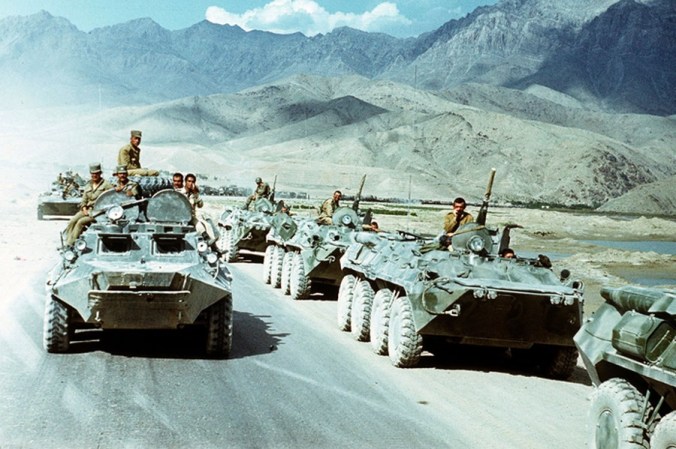
On May 26th, 1972, U.S. President Richard Nixon and Soviet General Secretary Leonid Brezhnev signed an agreement limiting the use of anti-ballistic missiles (Strategic Arms Limitations Talks). This agreement, known as the SALT I treaty, would mark the beginning of détente between the two superpowers. However, this thaw in the Cold War would not bring international peace. For example, the United States was still worried about the Soviet Union’s funneling of foreign aid and military assistance in the developing world (Freeze, pg 445). Détente would finally end with the Soviet invasion of Afghanistan.
The Soviets would intervene on the invitation of Hafizullah Amin, leader of the Democratic Republic of Afghanistan, and help prop-up the Marxist government in place (Invasion of Afghanistan). Brezhnev, Polk writes, “feared that a Communist failure in Afghanistan would impact on the Tajiks, Uzbeks, and other Turkoman peoples of Soviet Central Asia, infecting them with anti-Communist aspirations” (Polk, pg 182). Citing the 1978 Treaty of Friendship, Soviet forces were brought into Afghanistan on December 25th, 1979 (Invasion of Afghanistan). Two days later, Soviet forces would back a coup which would kill Amin and install Babrak Kamal (Politbiuro Report).
Fighting would last for almost ten years between Soviet armed forces and insurgent groups, known as Mujahideen (Invasion of Afghanistan). These mujahideen would avoid direct conflict and use Afghanistan’s mountains to avoid Soviet advantages in arms and technology (Invasion of Afghanistan). In the spirit of the Cold War, the United States covertly supported any Afghan group that would oppose the Soviets (Polk, pg 194). After the introduction of American anti-air weapons to mujahideen, the Soviet lost their air superiority and retreated to cities, occupying only one fifth of the country (Polk, pg 199-200). In the end, the Soviet Union would withdraw in 1989 having nothing to show but heavy casualties and a damaged international standing (Freeze, 446).
 This post was featured on Comrade’s Corner
This post was featured on Comrade’s Corner
Sources:
Freeze, Gregory. Russia a History. 3rd edition. Oxford University Press. 2009.
Politbiuro Report on Afghanistan. Seventeen Moments in Soviet History. http://soviethistory.msu.edu/1980-2/invasion-of-afghanistan/invasion-of-afghanistan-texts/politbiuro-report-on-afghanistan/
Polk, William R. Violent Politics: A History of Insurgency, Terrorism and Guerrilla Warfare. New York, NY: Harper Collins, 2007. Print.
Strategic Arms Limitations Talks/Treaty (SALT) I and II. Department of State. https://history.state.gov/milestones/1969-1976/salt
Von Geldern, James. Invasion of Afghanistan. Seventeen Moments in Soviet History. http://soviethistory.msu.edu/1980-2/invasion-of-afghanistan/
Image source:
Evstafiev, Mikhail. Soviet Withdrawal. 1988. Accessed: http://soviethistory.msu.edu/1980-2/invasion-of-afghanistan/invasion-of-afghanistan-images/#bwg190/972
I really like how you pointed out that towards the end of the war they basically only controlled urban centers which the Afghan resistance cared nothing about. It’s kind of like the Vietnam War – we could take all the cities we wanted but the Viet Cong and NVA controlled the jungles and non-urban areas. It was an unwinnable position the Soviets found themselves in. Great and informative post!
LikeLike
Thanks for putting the invasion of Afghanistan in the broader context of detente, and for highlighting the significance of ethnicity — at least in the minds of the Soviet leaders — when deciding to intervene in Afghanistan. Good research for this post!
LikeLike